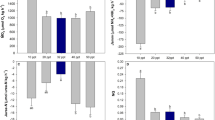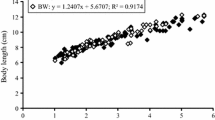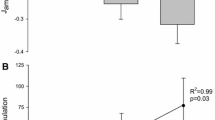Abstract
Acute toxicity bioassays conducted at various salinities demonstrated that mercury (as mercuric chloride) at low concentrations was lethal to Petrolisthes armatus. Ninety-six hour LC50 values varied from 50 to 64 parts per billion (ppb) of mercury, depending on test salinities. Lower salinities. decreased the time to death of mercuryexposed crabs. Differences in survival after 96 h due to salinity were not statistically significant. Blood chloride concentrations were regulated hyperchloride to the medium at low salinities and hypochloride at high salinities by acclimated crabs. The salinity isochloride to blood was 20‰ S. Transfer of crabs from 15‰ S to salinities ranging from 7 to 35‰ S resulted in new steadystate chloride levels within 12 h. Exposure to 50 ppb mercury did not alter chloride ion regulation of either acclimated crabs or crabs adjusting to new salinities.
Similar content being viewed by others
Literature Cited
Abou-Donia, M.B. and D.B. Menzel: Fish brain cholinesterase-its inhibition by carbamates and automatic assay. Comp. Biochem. Physiol. 21, 99–108 (1967)
P.H.A.: Standard methods for the examination of water and waste water, 874 pp. New York: American Public Health Ass. 1971
Pallard, J.A. and W.D. Oliff: A rapid method for measuring the acute toxicity of dissolved materials to marine fishes. Water Res. 3, 313–333 (1969)
Binet, L. et P. Nicolle: Influence du degré de salinité du milieu sur la toxicité du chlorure mercurique pour les épinoches. C. r. Séanc. Soc. Biol. 134, 562–565 (1940)
Corner, E.D.S. and F.H. Rigler: The modes of action of toxic agents. II. Mercuric chloride and n-amyl-mercuric chloride on crustanceans. J. mar. biol. Ass. U.K. 37, 85–96 (1958)
De Coursey, P.J. and W.B. Vernberg: Effects of mercury on survival, metabolism and behavior of larval Uca pugilator (Brachyura). Oikos 23, 241–247 (1972)
Dehnel, P.A.: Chloride regulation in the crab Hemigrapsus nudus. Physiol. Zoöl. 39, 259–265 (1966)
Eisler, R.: Annotated bibliography on biological effects of metals in aquatic environments, 287 pp. Corvallis, Oregon: National Environmental Research Center, Office of Research and Monitoring, U.S. Environment Protection Agency, 1973
Gross, W.J.: An analysis of response to osmotic stress in selected decapod Crustacea. Biol. Bull. mar. biol. Lab., Woods Hole 112, 43–62 (1957)
Haig, J.: The Galatheidae (Crustacea: Anomura) of the Allan Hancock Expedition with a review of the Porcellanidae of the western North Pacific. Rep. Allan Hancock Atlant. Exped. 8, 1–44 (1956)
Jackim, E., J.M. Hamlin and S. Sonis: Effects of metal poisoning on fish liver enzymes in the killifish (Fundulus heteroclitus). J. Fish. Res. Bd Can. 27, 383–390 (1970)
Kinne, O.: Salinity: animals — invertebrates. In: Marine ecology, Vol. I. Environmental factors. Part 2. pp 821–995. Ed. by O. Kinne, London: Wiley Interscience 1971
Lucu, Č, D. Siebers and K.R. Sperling: Comparison of osmoregulation between Adriatic and North Sea Carcinus. Mar. Biol. 22, 85–95 (1973)
Portman, J.E.: Progress report on a programme of insecticide analysis and toxicity testing in relation to the marine environment. Helgoländer wiss. Meeresunters. 17, 247–256 (1968)
Prosser, C.L.: Comparative animal physiology, 966 pp. Philadelphia: W.B. Saunders Co. 1973
Saha, J.G.: Significance of mercury in the environment. Residue Rev. 42, 103–163 (1972)
Smaldon, G.: Osmoregulation in Pisidia longicornis (L.) and Porcellana platycheles (Pennant) (Decapoda: Anomura) subjected to reduced salinities Comp. Biochem. Physiol. 44A, 893–895 (1973)
Thurberg, F.P., M.A. Dawson and R.S. Collier: Effects of copper and cadmium on osmoregulation and oxygen consumption in two species of estarine crabs. Mar. Biol. 23, 171–175 (1973)
Vernberg, W.B., P.J. DeCoursey and W.J. Padgett: Synergistic effects of environmental variables on larvae of Vca pugilator. Mar. Biol. 22, 307–312 (1973)
— and J. Vernberg: The synergistic effects of temperature, salinity, and mercury on survival and metabolism of the adult fiddler crab, Uca pugilator. Fish. Bull. U.S. 70, 415–420 (1972)
Author information
Authors and Affiliations
Additional information
Communicated by O. Kinne, Hamburg.
Rights and permissions
About this article
Cite this article
Roesijadi, G., Petrocelli, S.R., Anderson, J.W. et al. Survival and chloride ion regulation of the porcelain crab Petrolisthes armatus exposed to mercury. Marine Biology 27, 213–217 (1974). https://doi.org/10.1007/BF00391946
Accepted:
Issue Date:
DOI: https://doi.org/10.1007/BF00391946




